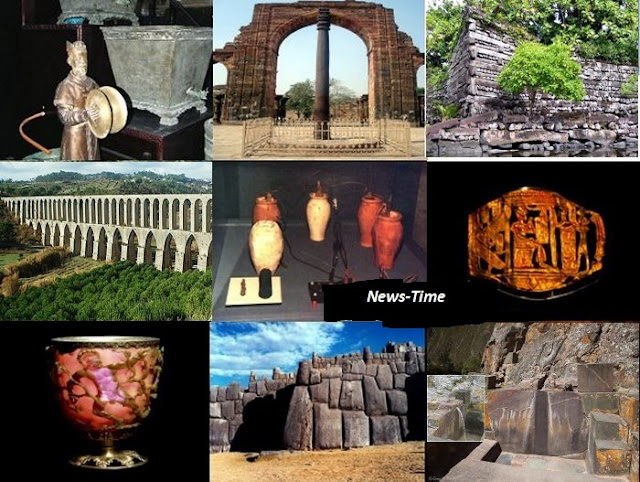Ancient technology is totally different from modern technology there's tons of evidence that our ancestors have the talents and skills that we lack today. We may know some processes, but not all of them .Here are some of ancient technologies that were way ahead of their time. A 5000-year-old water system has been unearthed by archaeologists in Iran during a rescue excavation project at Seimareh Dam reservoir .
The water system consists of a small pool and a long earthenware pipeline Each earthenware pipe measures about one metre in length and its likely that the structure was made and baked in this region . The Persians, as we know them, were one of the first civilizations to implement an advanced water supply system and one of the greatest aqueduct builders of the ancient world In the Qutub complex of Delhi stands one of the most curious metal objects called the Iron Pillar of Delhi Having an existence of around 1600 years, the pillar is almost 24 feet high and weighs more than 6 tons .
It is famous for its non-rusted state, despite being made of 99% iron, and having been constructed in the 5th century CE . However, some theories say it is probably humidity factors or the quality of the materials used that caused a protective layer to appear on the pillar . The Lycurgus cup is one of the most fascinating artifacts from 4th-century AD .The cup is made of dichromatic glass, which displays different colors depending on whether the light is passing through Its turn red when lit from behind and green when lit from in front . After scientific analysis, they found that the gold and silver inclusions had been purposefully ground down to their very small size before being added to the glass In fact, the exact mixture of the metals shows that the Romans had perfected the use of nanoparticles In 132 CE, a Chinese scientist named Zhang Heng invented the world's first seismoscope, an instrument to detect earthquakes.
From the historical descriptions, seismoscope is formed by giant bronze vessel, six feet in diameter, with eight dragon heads arranged round the rim Each dragon face one of the eight directions and holding a ball in its mouth By looking at which balls dropped, it was believed that the earthquake's location could be pinpointed The exact mechanism that caused the ball to drop during an earthquake is still unknown
The water system consists of a small pool and a long earthenware pipeline Each earthenware pipe measures about one metre in length and its likely that the structure was made and baked in this region . The Persians, as we know them, were one of the first civilizations to implement an advanced water supply system and one of the greatest aqueduct builders of the ancient world In the Qutub complex of Delhi stands one of the most curious metal objects called the Iron Pillar of Delhi Having an existence of around 1600 years, the pillar is almost 24 feet high and weighs more than 6 tons .
It is famous for its non-rusted state, despite being made of 99% iron, and having been constructed in the 5th century CE . However, some theories say it is probably humidity factors or the quality of the materials used that caused a protective layer to appear on the pillar . The Lycurgus cup is one of the most fascinating artifacts from 4th-century AD .The cup is made of dichromatic glass, which displays different colors depending on whether the light is passing through Its turn red when lit from behind and green when lit from in front . After scientific analysis, they found that the gold and silver inclusions had been purposefully ground down to their very small size before being added to the glass In fact, the exact mixture of the metals shows that the Romans had perfected the use of nanoparticles In 132 CE, a Chinese scientist named Zhang Heng invented the world's first seismoscope, an instrument to detect earthquakes.
From the historical descriptions, seismoscope is formed by giant bronze vessel, six feet in diameter, with eight dragon heads arranged round the rim Each dragon face one of the eight directions and holding a ball in its mouth By looking at which balls dropped, it was believed that the earthquake's location could be pinpointed The exact mechanism that caused the ball to drop during an earthquake is still unknown







0 Comments